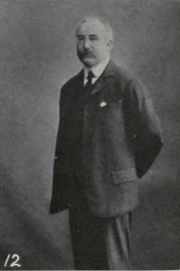Robert Shewan
| Robert Gordon Shewan | |
|---|---|
 | |
| Member of the Legislative Council of Hong Kong | |
| In office 23 June 1902 – 7 December 1905 | |
| Appointed by | Sir Henry Arthur Blake |
| Preceded by | T. H. Whitehead |
| Succeeded by | E. A. Hewett |
| In office 25 May 1917 – 27 December 1917 | |
| Appointed by | Sir Francis Henry May |
| Preceded by | Edward Shellim |
| In office 1 January 1919 – 23 December 1919 | |
| Preceded by | Edward Shellim |
| Succeeded by | S. H. Dodwell |
| Personal details | |
| Born | 13 November 1859 London, England |
| Died | 14 February 1934 (aged 74) British Hong Kong |
| Resting place | Hong Kong Cemetery |
| Spouse(s) | Dorothy "Dolly" |
| Occupation | Businessman |
Robert Gordon Shewan (13 November 1859 – 14 February 1934) was a Scottish businessman in Hong Kong.
Biography
Shewan was born in London on 13 November 1859, son of Andrew Shewan, master mariner, and Jane Thomson. He arrived in Hong Kong in 1881 in connection with the American trading house Russell & Co., then one of the largest mercantile firms in the East and subsequently took over the business of the house with another Englishman Charles Alexander Tomes in that firm and changed its name to Shewan, Tomes & Co. in 1895.[1]
With the trading house of Shewan Tomes he formed the Green Island Cement Company and the China Light and Power Company, which generated electricity for Kowloon. He was later on oust by the principal shareholder of the electricity company, Kadoorie family. He was also the director of the Hongkong and Shanghai Banking Corporation and of many other local companies.[2]
In 1902 Shewan was elected as the representative of the Hong Kong General Chamber of Commerce in the Legislative Council.
Shewan took a hard line during the Canton-Hong Kong strike in 1925 as he told the Daily Press the employers should punish their Chinese labours who went on strike. He also said he had posted a notice to his office boys and clerks who went out stating that if they did not return by the next morning they never need to come back at all.[3]
He died on 14 February 1934 and was buried at the Hong Kong Cemetery in Happy Valley, Hong Kong.
References
- ↑ Braga, Stuart (October 2012). "Making Impressions: The adaptation of a Portuguese family to Hong Kong, 1700-1950". p. 34.
- ↑ Wright, Arnold, ed. (1908). Twentieth Century Impressions of Hongkong, Shanghai, and other Treaty Ports of China. London: Lloyd's Greater Britain Pub. Co. p. 173.
- ↑ "No Weakness.". Hong Kong Daily Press. 24 July 1925. p. 3.
| |||||||||||||||||